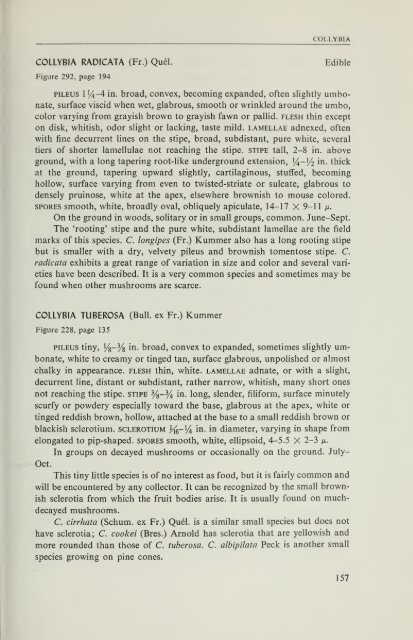Create successful ePaper yourself
Turn your PDF publications into a flip-book with our unique Google optimized e-Paper software.
COLLYBIA<br />
COLLYBIA RADICATA (Fr.) Quel. Edible<br />
Figure 292, page 194<br />
PILEUS 1 J4-4 in. broad, convex, becoming expanded, often slightly umbonate,<br />
surface viscid when wet, glabrous, smooth or wrinkled around the umbo,<br />
color varying from grayish brown to grayish fawn or paUid. flesh thin except<br />
on disk, whitish, odor shght or lacking, taste mild, lamellae adnexed, often<br />
with fine decurrent hnes on the stipe, broad, subdistant, pure white, several<br />
tiers of shorter lamellulae not reaching the stipe, stipe tall, 2-8 in. above<br />
ground, with a long tapering root-Hke underground extension, i/^-^/z in. thick<br />
at the ground, tapering upward sHghtly, cartilaginous, stuffed, becoming<br />
hollow, surface varying from even to twisted-striate or sulcate, glabrous to<br />
densely pruinose, white at the apex, elsewhere brownish to mouse colored.<br />
spores smooth, white, broadly oval, obliquely apiculate, 14-17 X 9-11 /x.<br />
On the ground in woods, solitary or in small groups, common. June-Sept.<br />
The 'rooting' stipe and the pure white, subdistant lamellae are the field<br />
marks of this species. C longipes (Fr.) Kummer also has a long rooting stipe<br />
but is smaller with a dry, velvety pileus and brownish tomentose stipe. C.<br />
radicata exhibits a great range of variation in size and color and several vari-<br />
eties have been described. It is a very common species and sometimes may be<br />
found when other mushrooms are scarce.<br />
COLLYBIA TUBEROSA (Bull, ex Fr.) Kummer<br />
Figure 228, page 135<br />
PILEUS tiny, y%-Y% in. broad, convex to expanded, sometimes slightly um-<br />
bonate, white to creamy or tinged tan, surface glabrous, unpoHshed or almost<br />
chalky in appearance, flesh thin, white, lamellae adnate, or with a slight,<br />
decurrent line, distant or subdistant, rather narrow, whitish, many short ones<br />
not reaching the stipe, stipe %-% in. long, slender, fihform, surface minutely<br />
scurfy or powdery especially toward the base, glabrous at the apex, white or<br />
tinged reddish brown, hollow, attached at the base to a small reddish brown or<br />
blackish sclerotium. sclerotium 3^6~!4 in. in diameter, varying in shape from<br />
elongated to pip-shaped, spores smooth, white, ellipsoid, 4-5.5 X 2-3 /x.<br />
Oct.<br />
In groups on decayed mushrooms or occasionally on the ground. July-<br />
This tiny Httle species is of no interest as food, but it is fairly common and<br />
will be encountered by any collector. It can be recognized by the small brownish<br />
sclerotia from which the fruit bodies arise. It is usually found on much-<br />
decayed mushrooms.<br />
C. cirrhata (Schum. ex Fr.) Quel, is a similar small species but does not<br />
have sclerotia; C. cookei (Bres.) Arnold has sclerotia that are yellowish and<br />
more rounded than those of C. tuberosa. C. albipilata Peck is another small<br />
species growing on pine cones.<br />
157

















